By Jan Worth-Nelson
You can get almost every element of the good life at the Flint Farmers’ Market: fresh asparagus, triple cream brie, Michigan strawberries and tomatoes in season, premier pinot noir, flaky croissants. You can pick up locally-made honey, sauerkraut for your upset gut, Lake Superior stones to dangle from your wrists or earrings. You can get endless varieties of soothing oils, or in another aisle, colorful African dresses, witty “Mitten” teeshirts, ball caps and onesies.
What you might not be able to get is a parking place. But Karianne Martus, manager of the booming market, celebrating its fifth year since its controversial move downtown from a longtime locale along the Flint River, says, “We’ve got a plan for that.”
“An amazing five years”
Since opening at the airy, high-ceilinged former Flint Journal building in June, 2014, the Flint Farmers’ Market has more than doubled its number of visitors, added vendors, installed two “incubator” kitchens, hosted more than 250 community events, drawn the surprise and awe of countless out-of-towners, and garnered national accolades.
“It has been an amazing five years,” Martus says.
At a June birthday party, market officials cut a ribbon to a newly remodeled demonstration kitchen sponsored by ELGA Credit Union, and unveiled a new summer gathering spot, the “Pavilion Patio,” at the west end of the market.
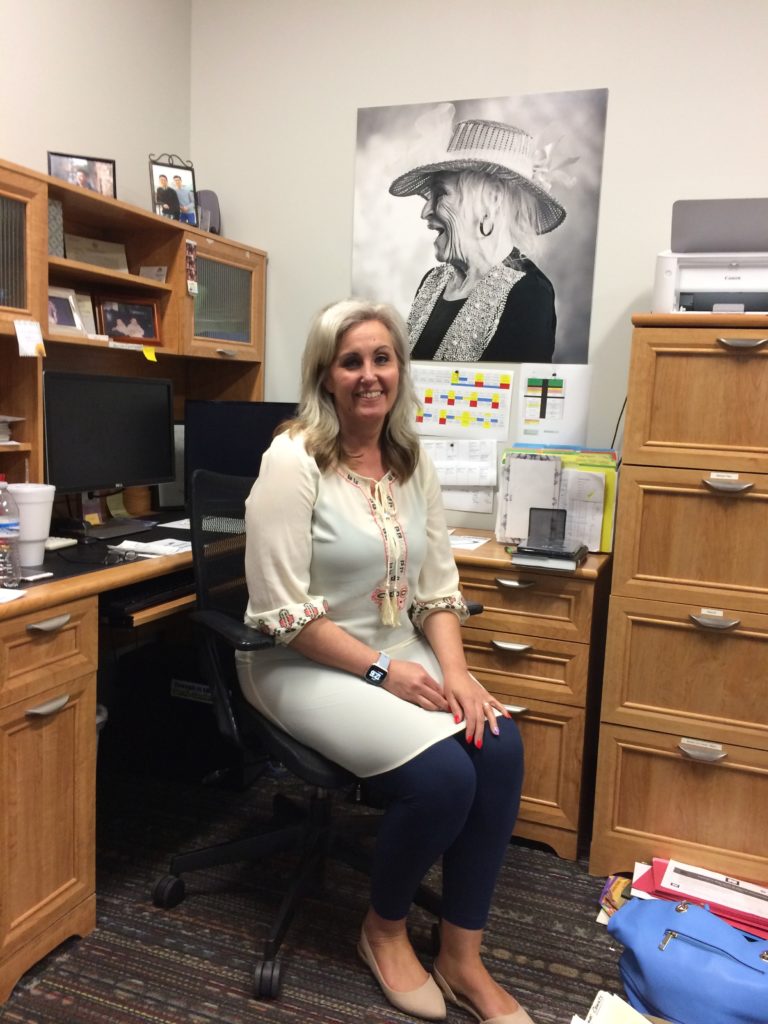
Farmers’ Market Manager Karianne Martus under a portrait of the late Paige Curran (Photo by Jan Worth-Nelson)
The expanded facility is privately owned by the nonprofit Uptown Reinvestment Corporation, which took over and redesigned the former Flint Journal’s press building, its high ceiling, balconies and tall windows offering dramatic settings for everything from roaming the aisles to meeting up with friends and colleagues.
Martus is in a second floor suite, the phones ringing repeatedly and people coming and going into the office, on a busy Tuesday afternoon.
She sits under a portrait of the late Paige Curran, much-loved owner of the Damascus Boutique upstairs at the old market–an independent and flamboyant woman who loved the market and whom Martus says she remembers with fondness.
The new market now boasts 45 year-round indoor vendors, up from 30 at the old site, and give-or-take 35 seasonal outdoor vendors May through December.
It offers three venues accommodating up to 150 each and two smaller venues for 25; among them, venue rentals have been the market’s biggest financial success so far.
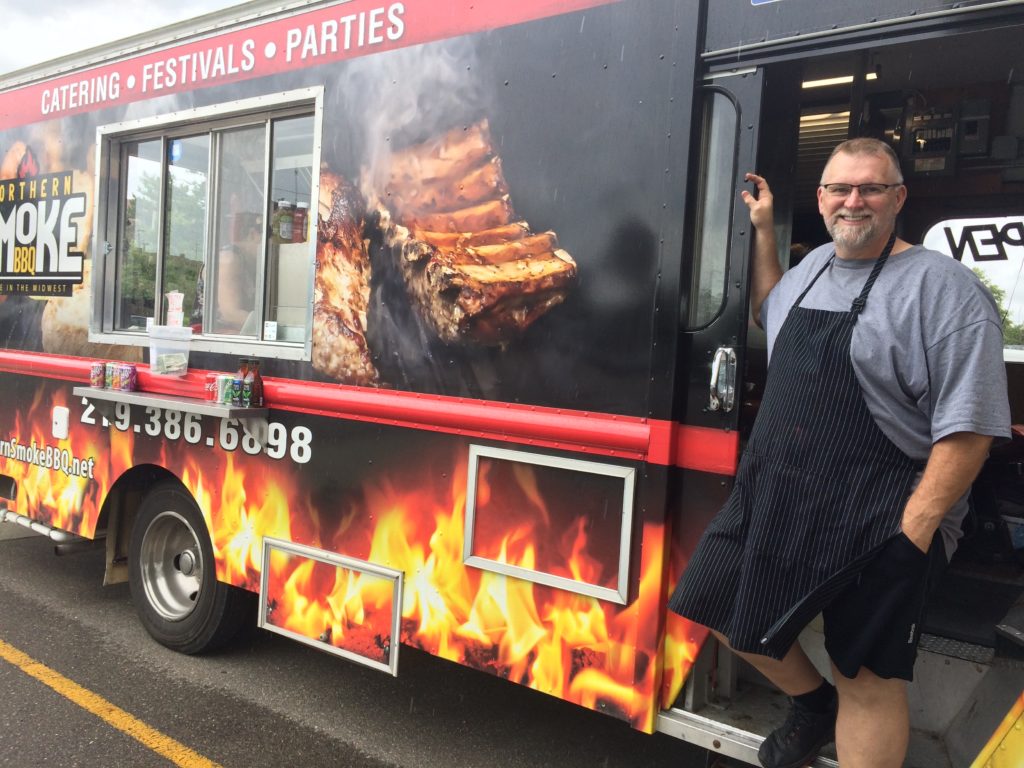
Dennis Stevens of Flushing says so far his barbecue truck busines is “going great” on the west end of the market (Photo by Jan Worth-Nelson)
This summer the market has two regular food trucks on the west patio–Northern Smoke BBQ and Mr. Prince’s Tacos. There’s is an ice cream cafe in a repurposed trolley car and a mini-marketplace set up by Flint Handmade.
Live music, always popular on the east end of the market, also is being added this summer in the west patio.
And while things are booming, Martus readily asserts the market faces ongoing challenges–the greatest being maintaining its cadre of local farmers–and complaints, the greatest being the ongoing headache of parking at the popular destination. But she strongly contends the market is up to meeting the needs and reels off plans and strategies for both.
Striving for the “Farmer” in “Farmers’ Market not always easy
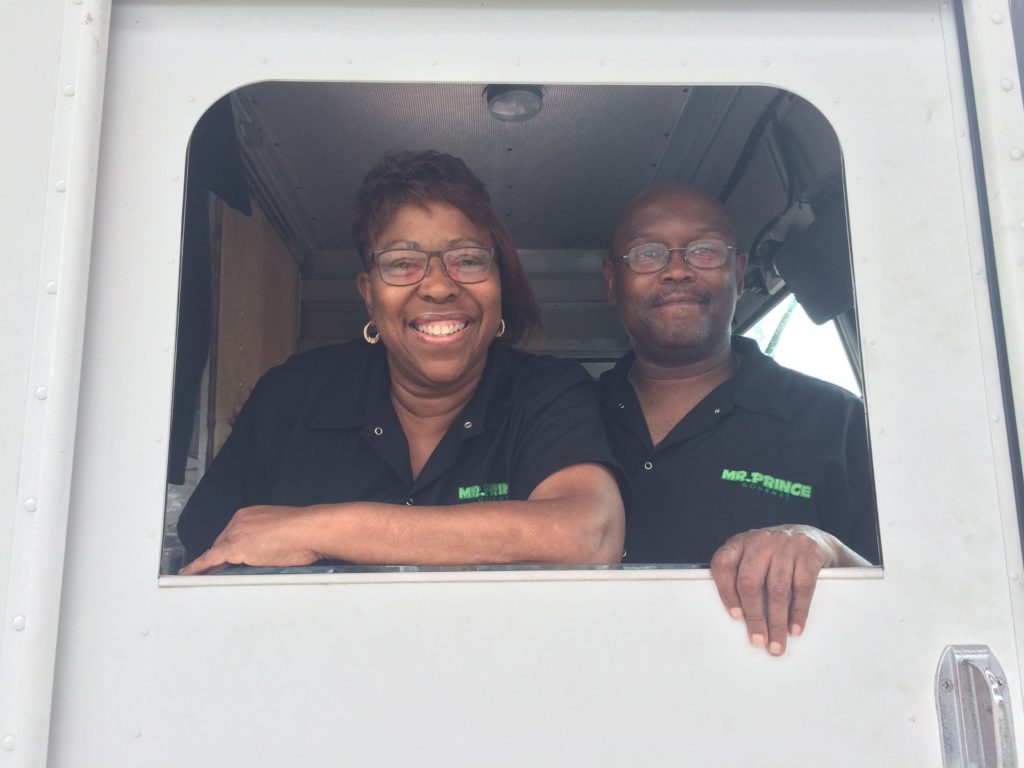
Theresa Chapman and her brother, Harold Prince, grandchildren of “Mr. Prince” selling tacos from their truck in the west end of the market (Photo by Jan Worth-Nelson)
Fulfilling expectations that the market is, indeed, a “farmers’ market” requires constant recruiting and support, Martus said. On Tuesdays and Thursdays this summer, only about 10 farmers fill stalls outside, 11 produce vendors on Saturdays outside, with about 70 percent of them growing the bulk of what they’re selling. Two inside vendors, Steady Eddy’s Veggies and Bushel and a Peck, are not farmers, getting their produce as fresh as possible from middleman producers like Detroit’s Eastern Market.
“They do as much Michigan as they can,” she says, “but also have bananas and other items not grown in Michigan.”
The Local Grocer and Simply Salads also offer fresh produce indoors. Simply Salads, out of Peck, Michigan, a two-hour drive each way, is one of Martus’s favorite success stories. It’s a student/parent/Future Farmers of America administered program, and they’ve been coming in on Saturdays for ten years.
“They have grown their business in more ways than one and they’ve established an excellent customer base,” she said–offering fresh greens year round in student-managed hoop houses.
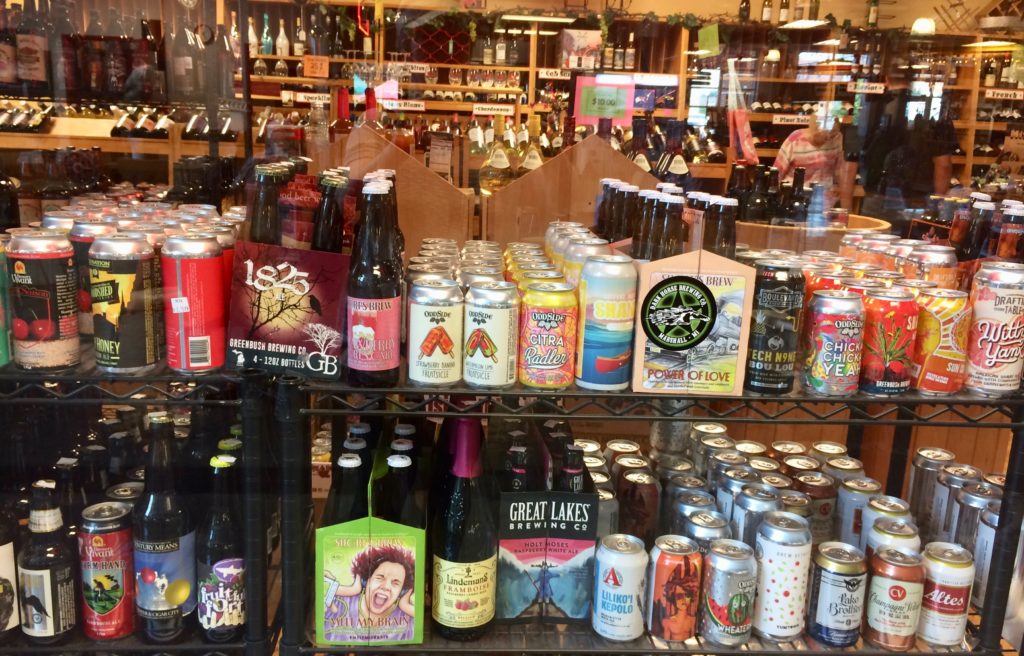
Craft beers on window display at D’vine Wines inside the market. Owner Maria Carlin says her business has “absolutely” increased since moving her popular shop from the old market (Photo by Jan Worth-Nelson)
“We’re called the Farmers’ Market but we’re really a ‘public market,’ ” Martus admits. “I’d like it if the whole thing was local. It’s not for lack of trying.
“It’s a matter of how can it be a viable income for people–let’s say, for young people getting started? What we keep seeing is people get very excited, they’ve got some land, they’re going to plant things and bring them in, and they’ll come down a few times and then we never see them again, because they didn’t sell enough.
“So many of the family farms are gone or the newest generation does not want to continue,” she said. At the old market, “We used to have six family farms with three stalls each.” Several didn’t join in the move, some retired, some left the business.
“Farming is really hard work and it’s expensive,” she said. Noting that some customers complain the market’s locally-grown produce costs more, she says, “The smaller, truly local stuff is more but that’s because it’s truly local and they’re out there on their hands and knees in the early morning harvesting it, and they simply don’t have the volume of the bigger producers.”
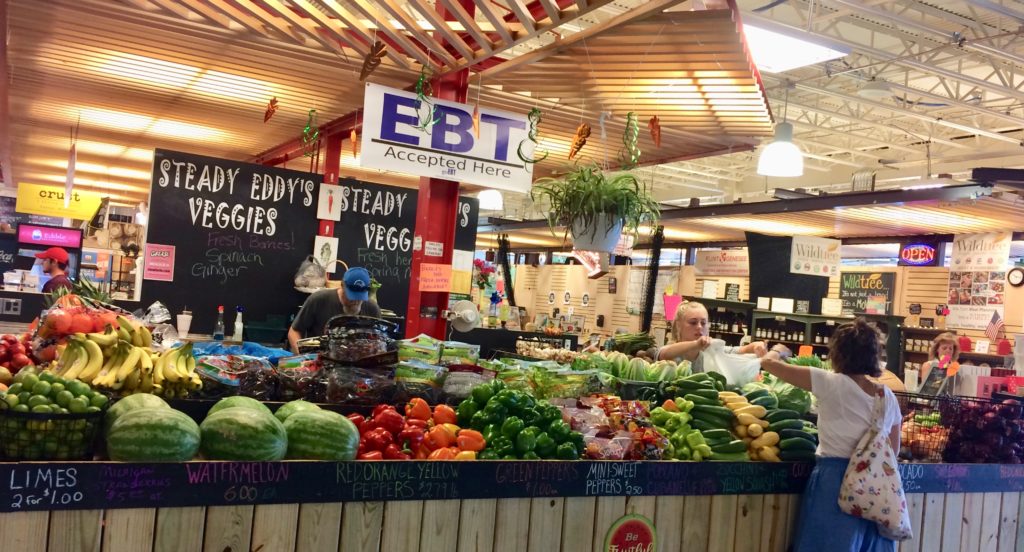
The indoor produce vendors at Steady Eddy’s Veggies are not farmers, but get produce from distributors in Detroit. (Photo by Jan Worth-Nelson)
Outside vendors are offered daily and monthly rates, $200 per table per month, $45 a day on Saturdays, $35 on Tuesdays and Thursdays. But some vendors, if they’re small farmers, simply can’t afford the time to come and stand by their produce all day when they should be actually farming it, she said.
Inside vendors are charged about $1.70/square foot, along with a flat surcharge for advertising, water, gas, telephone and WiFi.
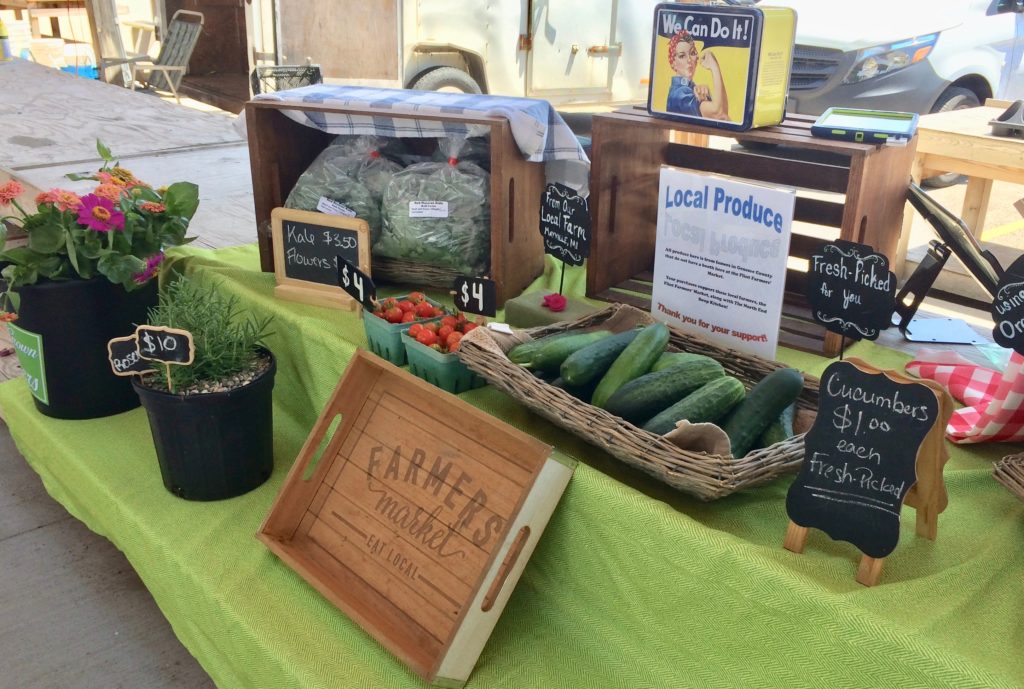
Local produce from the new Stony Creek Organics drop-off program (Photo by Jan Worth-Nelson)
So, this summer the market developed a program, suggested by former market manager Dick Ramsdell, with Stony Creek Organics to try to make it easier. Through the new arrangement, farmers bring their produce in early in the morning, Stony Creek buys it from them on the spot, and then offers it for sale so the farmers don’t have to stay.
On a recent Saturday, only three vendors had brought produce and fresh flowers in–picked that morning– but Stony Creek vendor LeAnn Luke of Mayville said she hopes the idea will catch on and expand. “My goal is to help build up people’s businesses so they can have their own stall,” she said.
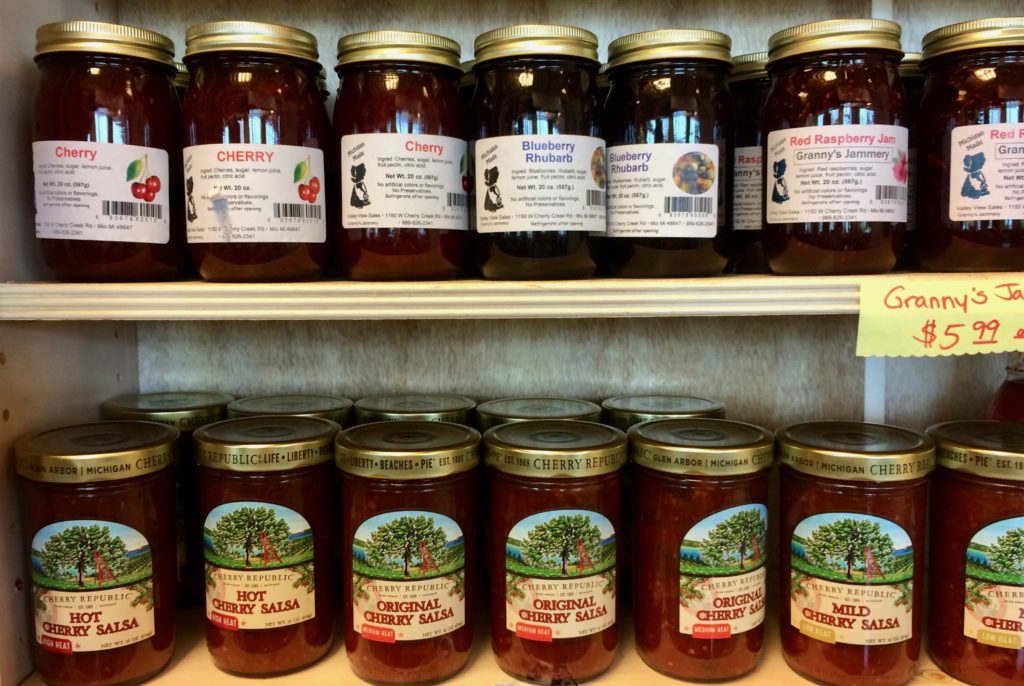
Michigan at the Market offers a range of jellies and jams (Photo by Jan Worth-Nelson)
“There used to be more greenhouses,” Martus notes, “but we’ve had a hard time with fresh flowers — the big box stores have bought them all up and are importing them or putting them out of business.”
Despite all that, Martus says the market runs a pretty continual waiting list and has been full since it opened downtown.
A crucial part of the market’s mission has been its outreach to customers using EBT cards and taking advantage of the Double-Up Bucks program. Martus says it has been a “fantastic success.”
The way the program works is if customers buy any fruits, veggies or milk with their Electronic Benefits Transfer(EBT) card, they get a dollar-for-dollar equal amount free to spend on any other fruits and vegetables, up to $20 a day.
Martus said the response has been incredible — with the in-house-run reimbursement, a program funded from the nonprofit Fair Food Network to vendors averaging more than $120,000 a year.

One of the stalls full of beautiful things (Photo by Jan Worth-Nelson)
About that parking…
As for the parking, the thorny situation has been a consequence in part of the market’s success and its commitment to keep parking free.
The market has the same number of parking spaces as at the old market, Martus notes–originally 250 to 300–but hardly enough, as it turns out, for more than twice the number of visitors. The opening of the MSU Medical School next door and Hurley offices on the second floor also have brought in more vehicles. And because the lot is free, it has been hijacked from time to time by UM – Flint students and others on nearby downtown business taking advantage of the market’s “no charge” approach. The market turns over spaces about every 45 minutes, Martus said, so cars staying longer than that can readily be spotted.
Market officials were tagging and towing a lot of cars, a public relations nightmare.
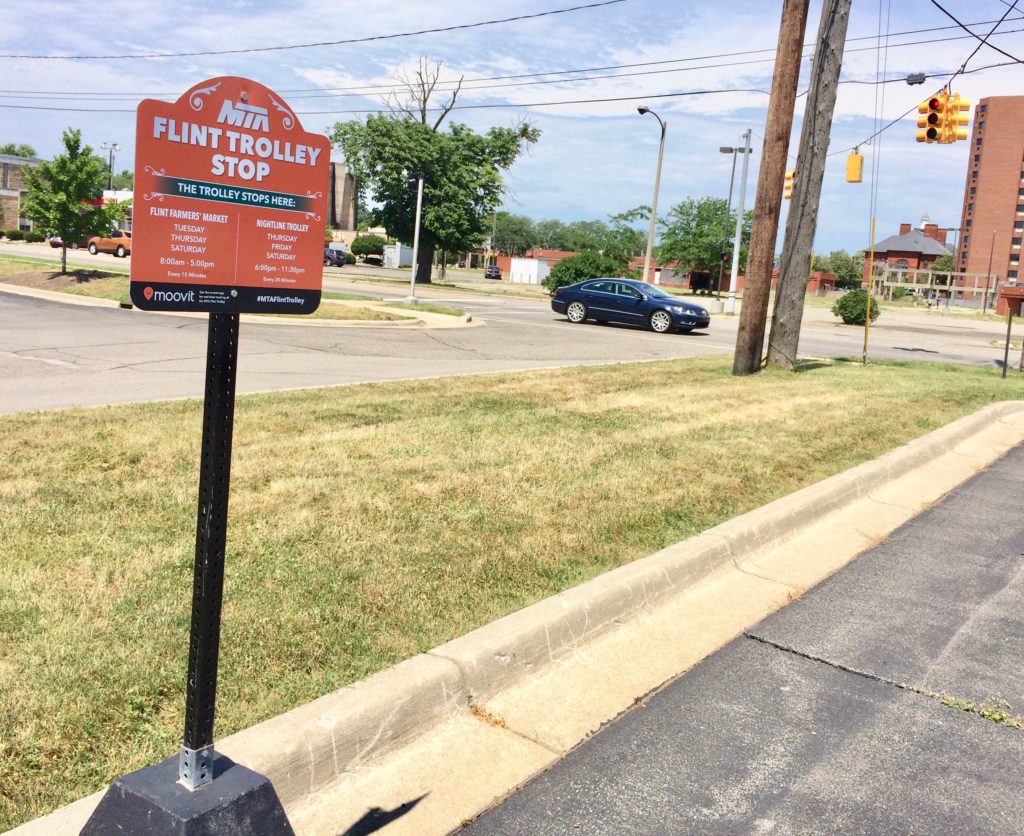
Look for the red trolley stop sign at the northwest end of the UM – Flint White Building lot. It’s a seven-minute free ride to the market from there. (Photo by Jan Worth-Nelson)
So the market has paired up with partners Downtown Development Authority, the UM – Flint and the nearby Mass Transportation Authority (MTA) to set up free trolley transport from the monitored and secured parking lot of UM – Flint’s White Building. The trolley operates 8 a.m to 5 p.m. every 15 minutes on market days — Tuesday, Thursday and Saturday — and 11 a.m. to 2 pm. on Monday, Wednesday and Friday.
The trolley makes eight stops on market days: UM Flint’s “S” lot at the far north corner of Saginaw Street and Robert T. Longway/Fifth Street; the Northbank Center, Churchhill’s, the Farmers’ Market, Third and Wallenberg, Saginaw and Second Street northbound, UM – Flint Pavilion, and Soggy Bottom Bar.
Martus said the trip from the UM – Flint lot to the market takes about seven minutes.
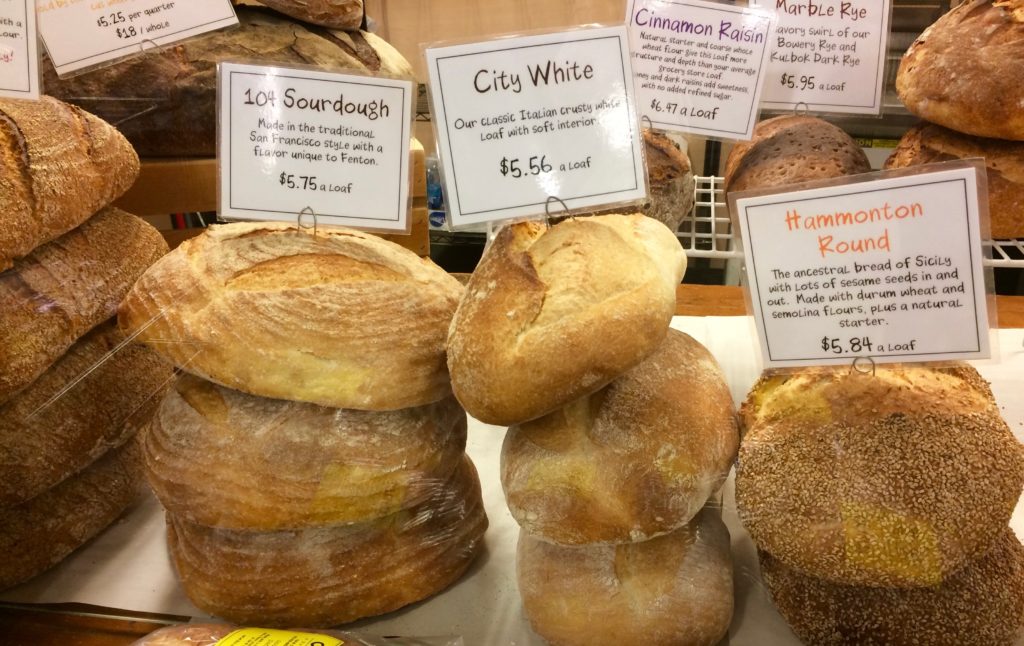
Fresh loaves at Crust (Photo by Jan Worth-Nelson)
Financial challenges continue
The new space has presented financial challenges, too.
“It’s a fantastic facility but it’s expensive to run,” Martus said. Electricity alone is about $19,000/month in the summer, not including gas, water, and phone.
“No one’s making money,” she said, noting that Uptown Reinvestment is a nonprofit operation. “We run a deficit every year. The attractions of the market bring in more people, and more people mean more expenses for upkeep, heating, and light.”
“If we tried to run this place only on the vendor fees we’d have to close up,” she said.
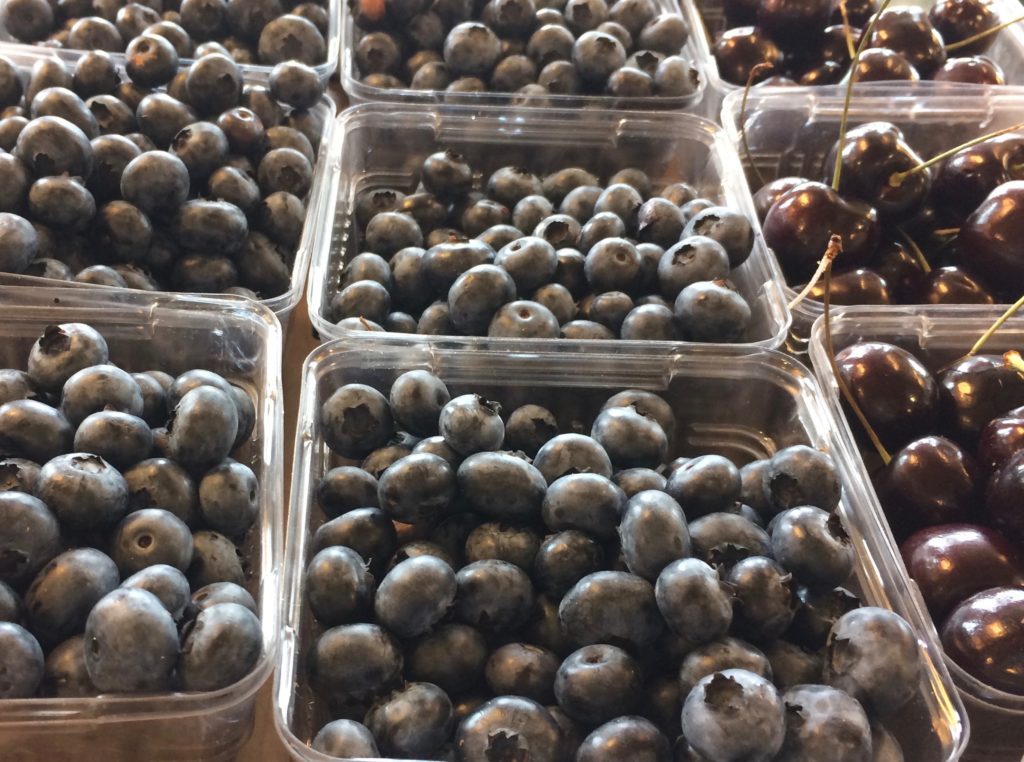
Fresh blueberries and cherries at Bushel and a Peck (Photo by Jan Worth-Nelson
“It would be nice if someday we’d be self-supporting” but so far community support–sponsors like ELGA Credit Union and HAP, along with booming event rentals — have made all the difference. That combination has kept Martus, the vendors, and the customers motivated and happy to be coming back again and again to a facility crucial, she says, to downtown’s health and revitalization.
The market, which fills a block between First and Second streets, is open 9 a.m. to 6 p.m. Tuesdays and Thursdays and 8 a.m. to 5 p.m. Saturdays.
EVM Editor Jan Worth-Nelson can be reached at janworth1118@gmail.com.



You must be logged in to post a comment.